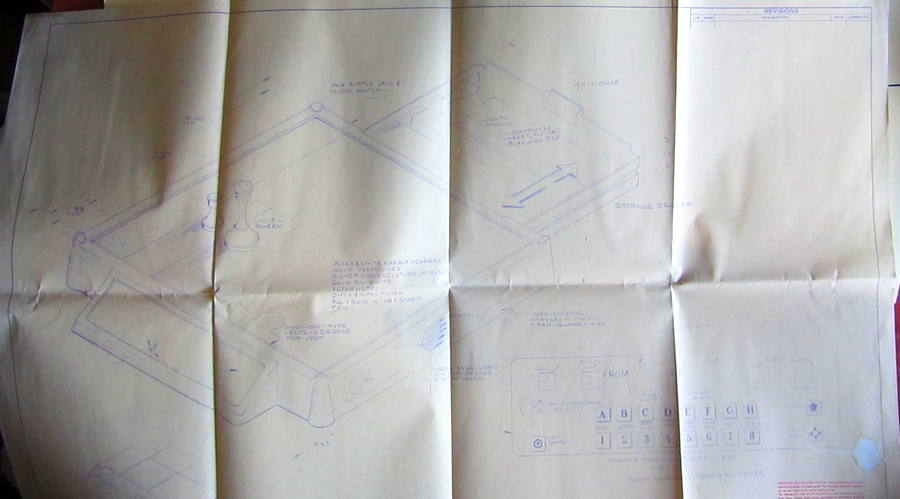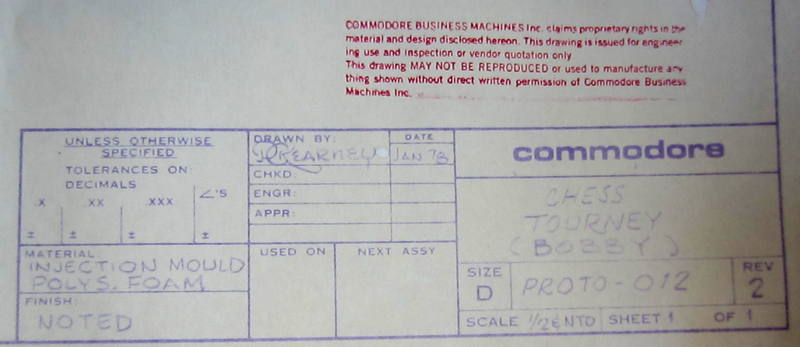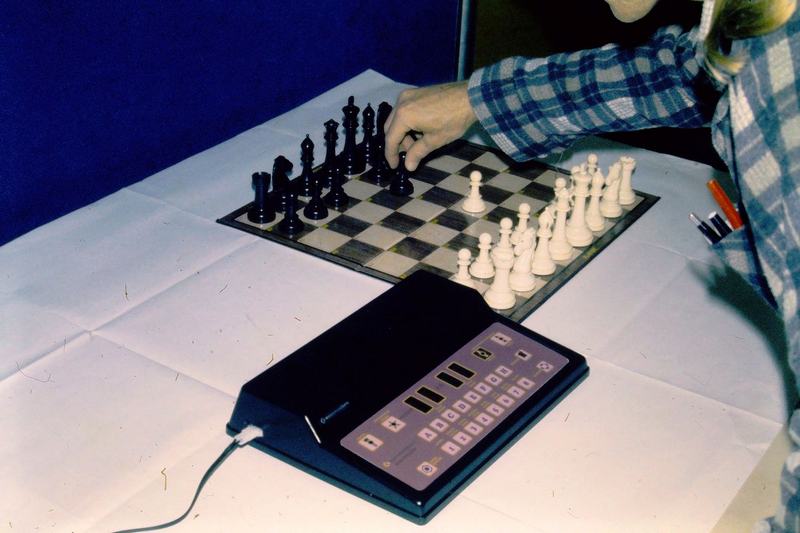The Commodore CHESSmate
Peter Jennings
November, 2023
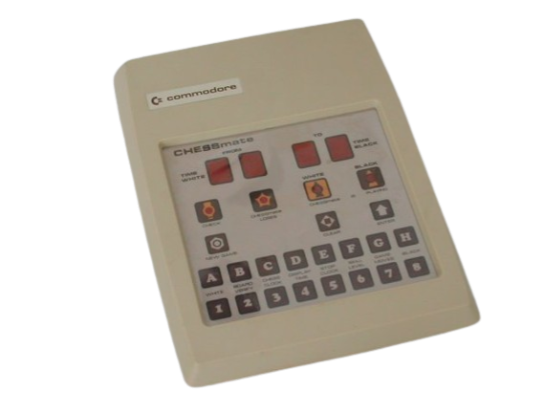
The CHESSmate was demonstrated at the January 1978 Consumer Electronics Show in Las Vegas as a prototype in order to assess customer interest in the product. It was available for order at the June 1978 CES in Chicago and the first units, manufactured in Hong Kong, shipped later that year. It was a big seller in Germany from the beginning.
In late 1976, as the Kim-1 Microchess was nearing completion, I began to contemplate a hardware dedicated computer version of Microchess. In 1975, before I had worked with microprocessors, I designed a series of games using only cheap TTL logic, LEDs and buttons to play games. Bowling and baseball were the first games I designed. At that time, I approached Mattel to explore the possibility of selling them my designs. Although the discussions never went very far, we kept in touch.
In December, George Klose, Senior Engineer at Mattel contacted me to discuss Microchess as a Mattel product. By mid-January we were to the point of discussing royalties and exclusivity. I was very optimistic that we would do a deal. But, unfortunately, a final agreement was never made. I have forgotten whether it was a disagreement over terms or a senior management decision regarding product fit.
A few years later, I was invited to Mattel's corporate office in El Segundo, California, to discuss porting VisiCorp products to the personal computer Mattel was considering manufacturing. In 1983 they introduced the Aquarius, but without any of our products.
Micro-ADE
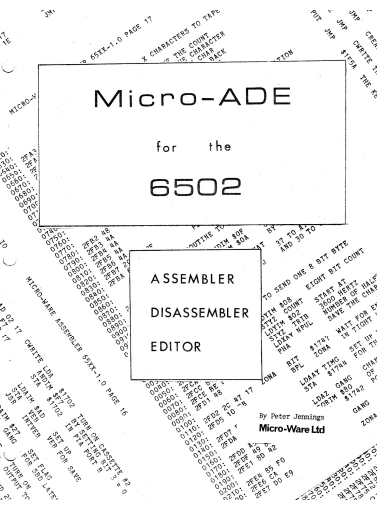 In early 1977, my main focus (other than holding down a full time job and shipping Microchess manuals and cassettes) was on creating a development system that would
run on the Kim-1. Rick Simpson from MOS Technology had provided me with an
extension board for the Kim-1 and an 8K memory board. With two cassette tape recorders
attached, and an ADM-3 CRT terminal (later replaced with a SOL-20 Terminal Computer), I was ready to get to work.
In early 1977, my main focus (other than holding down a full time job and shipping Microchess manuals and cassettes) was on creating a development system that would
run on the Kim-1. Rick Simpson from MOS Technology had provided me with an
extension board for the Kim-1 and an 8K memory board. With two cassette tape recorders
attached, and an ADM-3 CRT terminal (later replaced with a SOL-20 Terminal Computer), I was ready to get to work.
On May 1, 1977, I officially quit my job at ComShare and began full time work on developing and selling software for personal computers. At the Cleveland Computer Conference, later that month, I managed to buy a pair of surplus IBM 8 inch floppy diskette drives for $175. After poring over the hardware manuals for a few days, and with the help of Charles Sooley of Digitrol, we designed an interface between the Kim-1 and the disk drives that provided memory mapped I/O and hardware control. I wonder how many Kim-1s with dual disk drives ever existed.
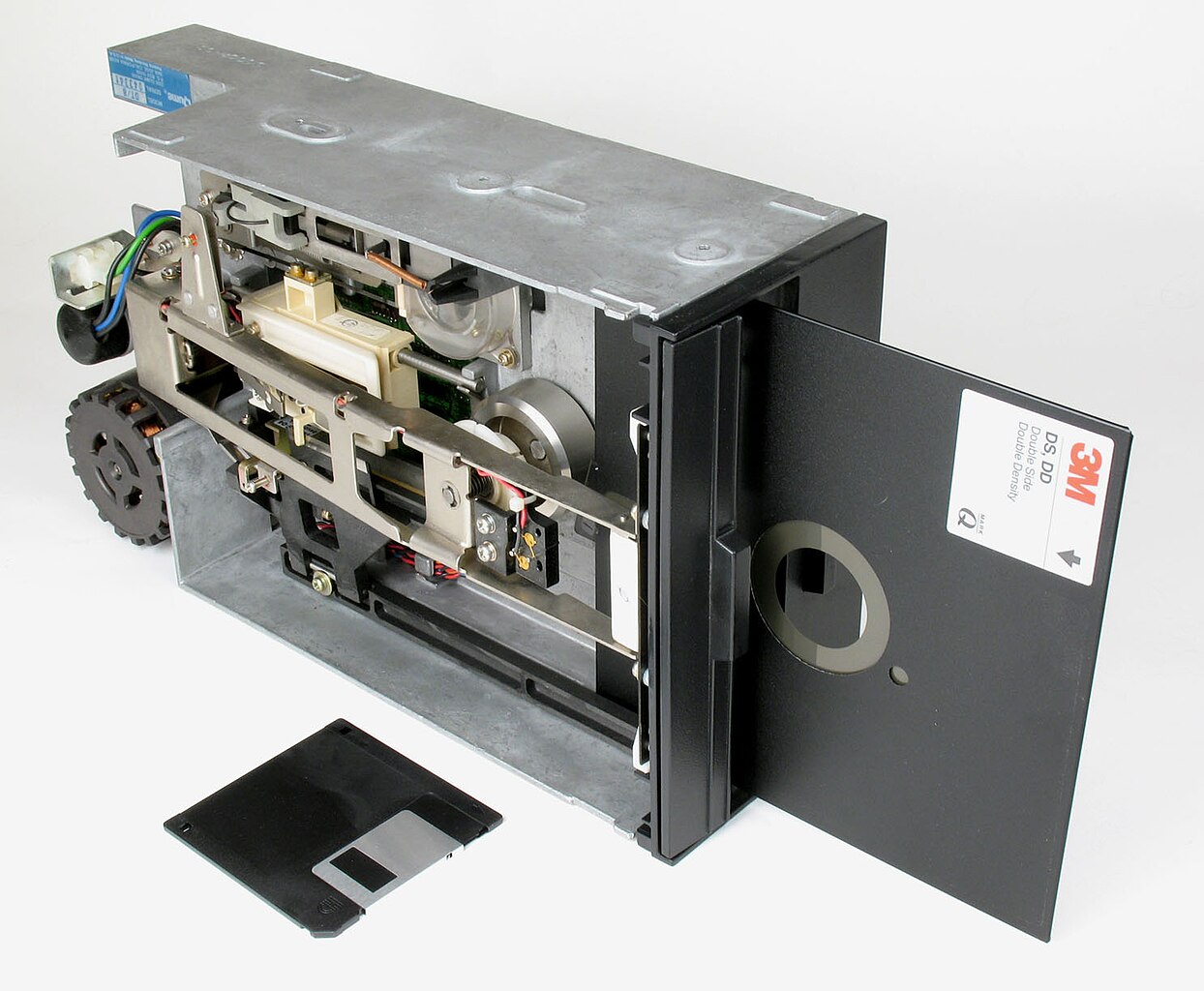 The cassette version of Micro-ADE was finished and shipping by June 1, so
I was able to quickly write a simple disk operating system and incorporate
it into the Micro-ADE code so that I could develop software more quickly.
Later, I was able to port Micro-ADE to the Apple ][ and use it to
create VisiDex. Sadly, the Apple ][ version
of Micro-ADE was never marketed as I
am sure many developers would have welcomed it.
I certainly used it to write many Apple programs and utilities,
including a file copy program that shipped with every
Corvus Disk Drive for the Apple ][ and ///.
The cassette version of Micro-ADE was finished and shipping by June 1, so
I was able to quickly write a simple disk operating system and incorporate
it into the Micro-ADE code so that I could develop software more quickly.
Later, I was able to port Micro-ADE to the Apple ][ and use it to
create VisiDex. Sadly, the Apple ][ version
of Micro-ADE was never marketed as I
am sure many developers would have welcomed it.
I certainly used it to write many Apple programs and utilities,
including a file copy program that shipped with every
Corvus Disk Drive for the Apple ][ and ///.
During the summer, after building the furniture for my home office out of MDF and particle board, I began work on improving Microchess for systems with more than 1K of memory.
Personal Computing '77 - Atlantic City
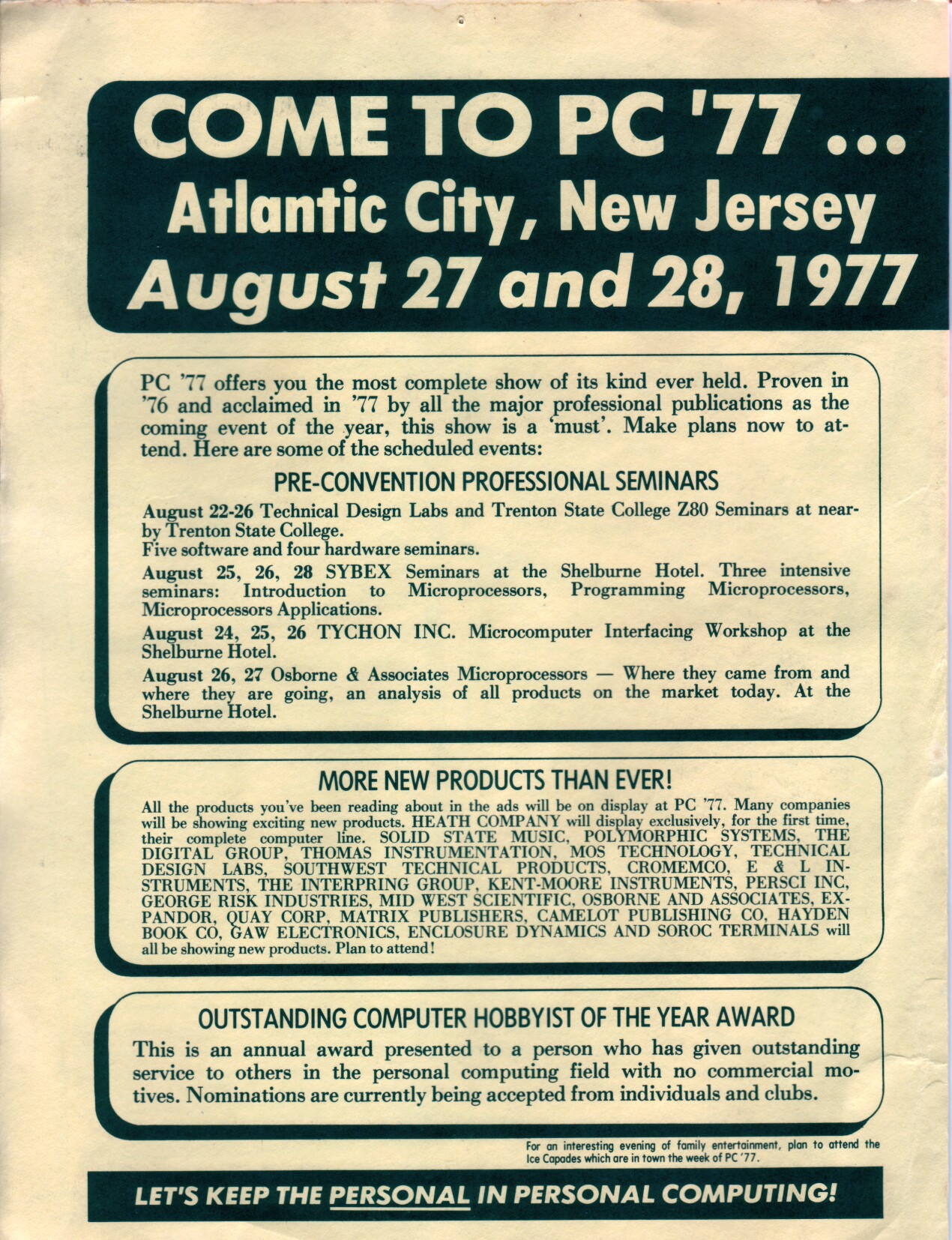 On August 27-28, 1977, the second annual Personal Computing Show was held in
Atlantic City. Micro-Ware had a table where we could sell our wares, consisting
of Microchess for the Kim-1 on cassette, for other 6502 systems on paper tape, Microchess
for 8080 machines on paper tape and Tarbell cassette, and Micro-ADE on cassette.
My wife, Jane, and I manned the table for the entire show. We sold almost
everything we had brought down with us. By the time the show was over,
we took home more cash than Jane’s annual salary as an actuary.
On August 27-28, 1977, the second annual Personal Computing Show was held in
Atlantic City. Micro-Ware had a table where we could sell our wares, consisting
of Microchess for the Kim-1 on cassette, for other 6502 systems on paper tape, Microchess
for 8080 machines on paper tape and Tarbell cassette, and Micro-ADE on cassette.
My wife, Jane, and I manned the table for the entire show. We sold almost
everything we had brought down with us. By the time the show was over,
we took home more cash than Jane’s annual salary as an actuary.
The cash was nice and it meant more new users, but the swarming fans who had already bought Microchess by mail order were overwhelming in their praise for the program and their gratitude to me for the many hours of pleasure they had derived from playing chess against their computers. Many of them had purchased a Kim-1 just to play Microchess. I don't know if I had felt it before, but from then on, solving problems, developing ideas and creating products that make people happy became my goal in life. It still is, and I relish the positive feedback I get from my projects and websites.
A few days before the show, Chuck Peddle called and invited us to have dinner with him and his beautiful wife, Shirley, on Saturday night. Chuck (or Commodore) treated us to a wonderful meal in an upscale restaurant at one of the finer hotels. Many cocktails and a bottle of wine were consumed. We all had a good time.
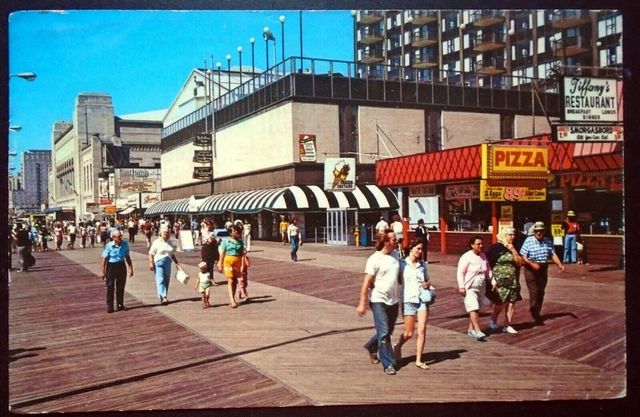 After dinner, Chuck asked me if I would like to take a walk with him on
the boardwalk. Enjoying the cool night air and the sounds of the surf, we strolled the length of
Atlantic City and Chuck proposed that I create a chess game for Commodore
to manufacture and sell.
The idea of a dedicated chess computer had always been on my mind, so
I did not need any convincing to design one.
I am not sure that Commodore would have been
my first choice, but I had not found a manufacturing partner yet and Chuck
was, as always, very persuasive.
After dinner, Chuck asked me if I would like to take a walk with him on
the boardwalk. Enjoying the cool night air and the sounds of the surf, we strolled the length of
Atlantic City and Chuck proposed that I create a chess game for Commodore
to manufacture and sell.
The idea of a dedicated chess computer had always been on my mind, so
I did not need any convincing to design one.
I am not sure that Commodore would have been
my first choice, but I had not found a manufacturing partner yet and Chuck
was, as always, very persuasive.
The Contract
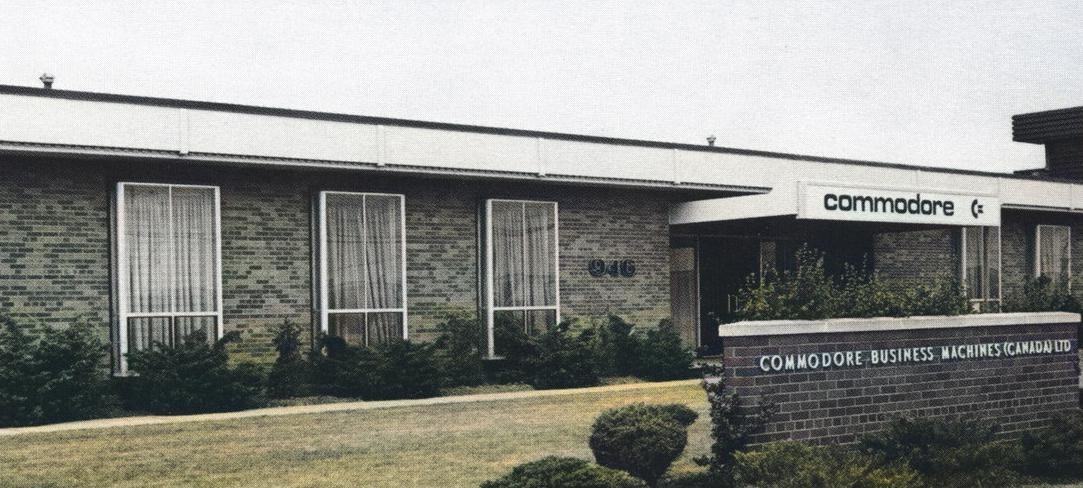 As I lived in Toronto and Sam Tramiel, Jack’s son, was CEO of
Commodore Canada, located in Scarborough, it was logical that the contract negotiations would
mainly be done with Sam.
As I lived in Toronto and Sam Tramiel, Jack’s son, was CEO of
Commodore Canada, located in Scarborough, it was logical that the contract negotiations would
mainly be done with Sam.
A draft contract was prepared in California and Sam and I sat down in his office to go through the details. I took the contract to my lawyer for his opinions and we made a number of comments for further discussions.
Among other things, the contract called for the new game to beat the Fidelity Chess Challenger (the only other game on the market at that time) consistently. He asked me what that meant. The concept of two machines playing chess against each other was so foreign that it took multiple attempts at explaining it to him before he grasped the situation.
Negotiations dragged on for months, but as I wanted to improve the play and design a dedicated game, I continued the development work anyway. Finally, we were down to a few final points and numbers awaiting agreement. Someone came up from California. I don't remember who. We sat in Sam's office and agreed on the royalty amounts. The one last sticking point was that I had requested an 18% interest on overdue payments. The "suit" from California pointed out that that was not necessary, because, of course, Commodore would always pay me promptly every quarter. I pointed out that if that was the case there could be no objection to the interest rate remaining in the contract, as nothing would ever be owed. He did not have an argument for that and we agreed that the clause would remain in the contract. I think I may have made more in interest than in royalties in the years that followed. I signed the contract and the "suit" took it back to California to be signed by Jack Tramiel, himself. I went back to working on the design. Although I referred to the head office representative as the "suit", this being 1977, I am pretty sure we were all wearing jackets and ties for the meetings.
Delivery
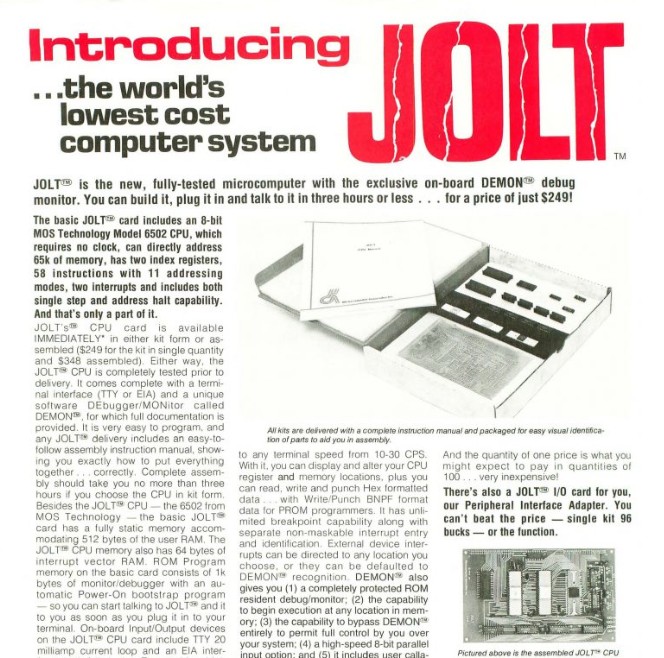 In early December, I got a phone call from Ray Holt, CEO of
Microcomputer Associates, and designer of the eponymous (in Spanish)
Jolt
6502 computer kit. Commodore had asked him to work with me on a prototype
that could be shown at the Consumer Electronics Show in Las Vegas during
the first week in January.
In early December, I got a phone call from Ray Holt, CEO of
Microcomputer Associates, and designer of the eponymous (in Spanish)
Jolt
6502 computer kit. Commodore had asked him to work with me on a prototype
that could be shown at the Consumer Electronics Show in Las Vegas during
the first week in January.
Together we designed a prototype that was somewhere between a Kim-1 and a Jolt single board computer with some extra bells and whistles, notably a speaker to emit game like sounds. The plan was that I would come to Palo Alto immediately after Christmas with a set of EPROMS that could be plugged into the prototype and together deliver the product to Commodore. My understanding was that Micromputer Associates had a significant overdue accounts receivable at Commodore for 6502 and RIOT chips and that his work would be credited against that account.
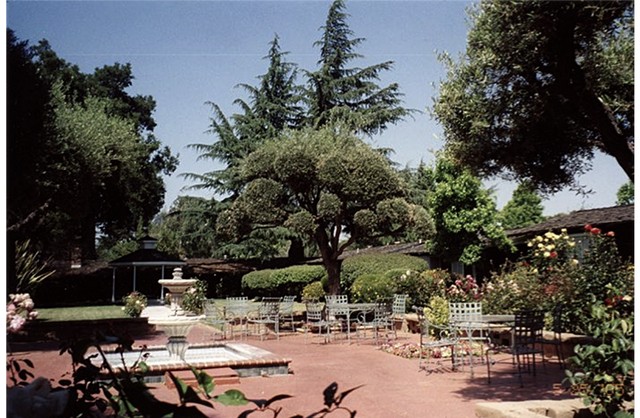 On Boxing Day, 1977, I flew to San Francisco and drove
to Rickey's Hyatt House on El Camino in Palo Alto in the
heaviest rainstorm I had ever seen. Built in 1952,
Rickey's was the go-to hotel in Silicon Valley for many
years. If the walls could talk, they would recount the negotiations
of many contracts and the celebrations of many IPOs.
Ronald Reagan stayed there when he was president. But,
in 1977, it seemed a bit run-down and smelled damp and musty from the
heavy rainfall.
On Boxing Day, 1977, I flew to San Francisco and drove
to Rickey's Hyatt House on El Camino in Palo Alto in the
heaviest rainstorm I had ever seen. Built in 1952,
Rickey's was the go-to hotel in Silicon Valley for many
years. If the walls could talk, they would recount the negotiations
of many contracts and the celebrations of many IPOs.
Ronald Reagan stayed there when he was president. But,
in 1977, it seemed a bit run-down and smelled damp and musty from the
heavy rainfall.
 As the torrential rainfall beat down on the roof of my
room, I opened the bathroom door to find a sign on the toilet.
If it's yellow, let it mellow. If it's brown, flush it down.
The rain outside signalled the end of the
1976-1977 California Drought. One of the worst in the state's
history. Welcome to California. My first visit.
As the torrential rainfall beat down on the roof of my
room, I opened the bathroom door to find a sign on the toilet.
If it's yellow, let it mellow. If it's brown, flush it down.
The rain outside signalled the end of the
1976-1977 California Drought. One of the worst in the state's
history. Welcome to California. My first visit.
The next morning, John Feagans and Bill Seiler showed up at my door to drive me to Microcomputer Associates to meet Ray Holt and his team. I carried with me the program listings and a paper tape containing the code we would need to program the PROMs for the prototype machine.
The moment of truth. The PROMs were programmed and inserted into the sockets on the PC board and power was applied. The LEDs came to life, but the computer would not do anything.
We huddled over the code seeking an explanation. It did not take long to realize that I was writing for a different 6530 RRIOT version from the one on the prototype PCB. Once that was understood there were only a few changes that needed to be made.
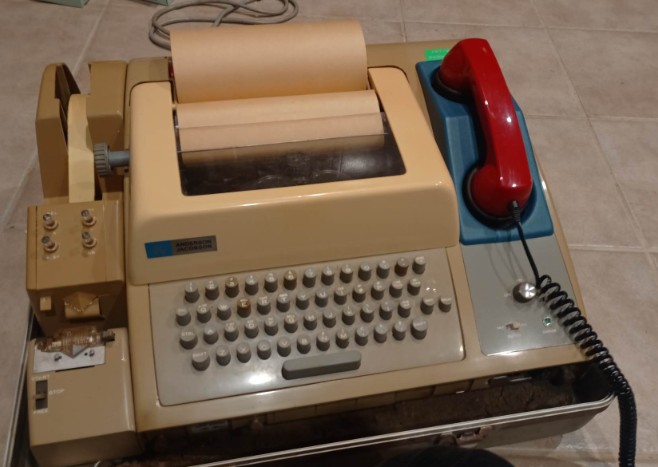 Preparation is the key to success. Before leaving Toronto, I had
connected an acoustic coupler modem to the serial input/output of the Kim-1
system on my desk. Ray had a teletype machine with a modem.
I called my wife and told her to turn on the computer and
place the phone in the acoustic coupler. In California, we started
the ASR33 teletype and pressed some keys. Incredibly, the Kim-1
responded as if the teletype was connected directly. A few changes
were made to the source code. Micro-ADE was run to compile the changes.
A dump of the binary file was transferred back over the phone line to the Teletype and punched
on paper tape ready to be burned into a new set of PROMs.
My Kim-1 in Toronto was certainly the only one in the world with dual floppy disks
and an acoustic coupler running a unique copy of Micro-ADE capable
of assembling the program.
Preparation is the key to success. Before leaving Toronto, I had
connected an acoustic coupler modem to the serial input/output of the Kim-1
system on my desk. Ray had a teletype machine with a modem.
I called my wife and told her to turn on the computer and
place the phone in the acoustic coupler. In California, we started
the ASR33 teletype and pressed some keys. Incredibly, the Kim-1
responded as if the teletype was connected directly. A few changes
were made to the source code. Micro-ADE was run to compile the changes.
A dump of the binary file was transferred back over the phone line to the Teletype and punched
on paper tape ready to be burned into a new set of PROMs.
My Kim-1 in Toronto was certainly the only one in the world with dual floppy disks
and an acoustic coupler running a unique copy of Micro-ADE capable
of assembling the program.
With the new PROMs, the prototype behaved as planned. We set up a chess board and played a game to ensure that it was working properly. We were ready to demonstrate the prototype to Jack Tramiel, himself. The man who regularly told everyone that business is war.
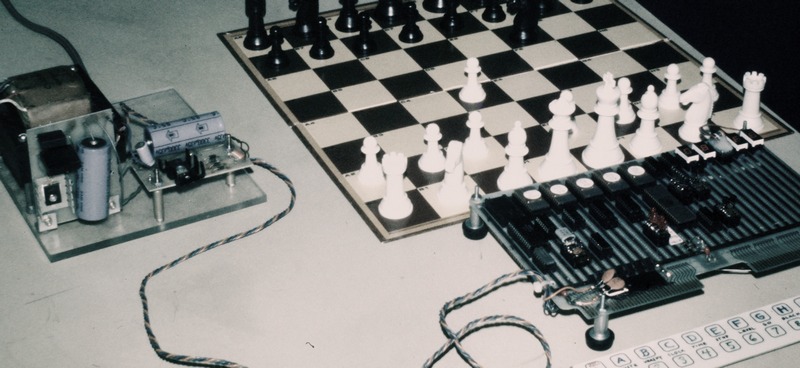
Early CHESSmate prototype
The next several days were spent meeting with various members of the Commodore team discussing options for the final game design, marketing plans and preparing a presentation to Jack to ensure his approval. My time with the people at Commodore was inspiring. From being a lone wolf programmer working alone for months, the project was now turned over to an efficient capable team of engineers and marketers. Their skills were truly impressive. I was unused to not being the smartest person in the room. I was used to being the only person in the room.
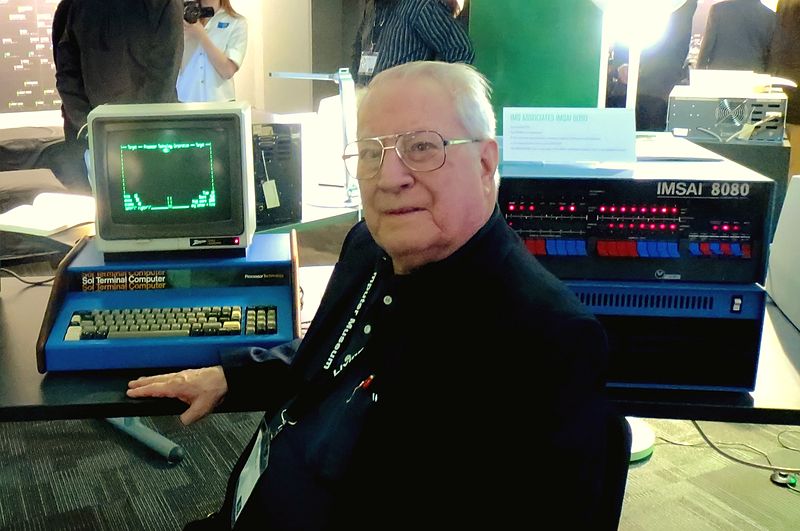 Gordon French invited me to his home to see the garage
where the Homebrew Club held its first meeting and to demonstrate the live steam engines he collected and worked on as a hobby. Chuck Peddle, John and Bill took me to lunch at various restaurants around the valley.
At one of those lunches, I tasted artichokes for the first time. John seriously
warned me not to eat the center choke as it was poisonous. I guess I still
presented as the rube from the sticks to these urbane Californians.
Gordon French invited me to his home to see the garage
where the Homebrew Club held its first meeting and to demonstrate the live steam engines he collected and worked on as a hobby. Chuck Peddle, John and Bill took me to lunch at various restaurants around the valley.
At one of those lunches, I tasted artichokes for the first time. John seriously
warned me not to eat the center choke as it was poisonous. I guess I still
presented as the rube from the sticks to these urbane Californians.
One morning, I came into the Commodore office to find that Chuck Peddle had been working all night, playing with some code to improve the sounds the computer made for various events. He demonstrated the sounds, which were much more interesting than my simple beeps. I looked at his code, usually extremely efficient and compact. Why, I asked, do you have seven ROL (rotate a byte in the accumulator one bit to the left) commands in a row here? He rolled his eyes. I forgot. We fixed the ROR bug. Up until mid 1976, the 6502 shipped with no ROR op code in the instruction set because of a bug in the silicon. After that the ROR was fixed and could be used to rotate a byte one bit to the right. He forgot! We replaced the seven ROL instructions with one ROR.
December 31, 1977. I was surprised how many were gathered in Jack's office for the presentation. Irving Gould, chomping on a cigar, popped his head in for a moment and left again. Chuck Peddle, John Feagans and Bill Seiler were there for tech support. There were others I didn't know.
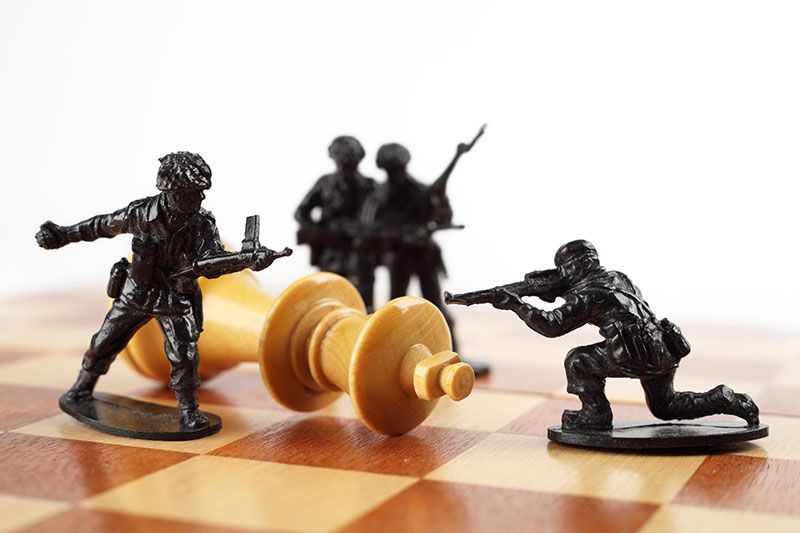 A chess board was set up on Jack's desk. A Fidelity Chess Challenger sat
beside it, ready to start a new game. Jack had not forgotten the key
term of the contract that the new product must beat the Chess Challenger head on.
Chess is War. Business is War. Here we go. The prototype was set down and plugged
in.
A chess board was set up on Jack's desk. A Fidelity Chess Challenger sat
beside it, ready to start a new game. Jack had not forgotten the key
term of the contract that the new product must beat the Chess Challenger head on.
Chess is War. Business is War. Here we go. The prototype was set down and plugged
in.
Jack operated the computers himself and moved the pieces on the wooden board. Microchess played white, the Chess Challenger played black. White immediately played a strong offensive strategy. The game lasted less than 10 moves. Chess Challenger was in checkmate. The board was set up again and Chess Challenger was given the white pieces this time. The result was the same. Given that I had been programming Microchess to beat the Chess Challenger for months, the outcome was a foregone conclusion. It would be very rare for this custom version of Microchess to lose against the current version of the Chess Challenger. It was almost as if Microchess could read its opponent's mind.
As the meeting moved on to marketing plans and preparation for the Consumer Electronics Show in a week's time, I carefully pried the PROMs from their slots, inserted them into a conductive foam pad and placed them in my shirt pocket. Nobody noticed.
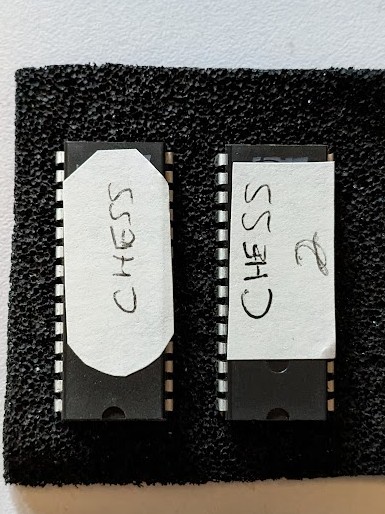 I was relaxing in my room later that afternoon when the phone rang.
The call was not unexpected. "We wanted to demo the prototype again
and the PROMs are missing!". "Yes, I know. I have them."
I was relaxing in my room later that afternoon when the phone rang.
The call was not unexpected. "We wanted to demo the prototype again
and the PROMs are missing!". "Yes, I know. I have them."
I explained that, although I had demonstrated the software, I did not have a signed contract yet. So I could not leave the PROMs in their hands. They explained that Jack had left for the afternoon. Could they get the PROMs back? I said, no. I need a signed contract first. A few hours later, it was already dark. There was a knock at the door. Someone had been dispatched to find Jack, get him to sign the contract, and deliver it to me. I heard that he was at a New Year's Eve party and was not happy to be disturbed. I handed over the black conductive foam pad containing the PROMs. At 9 pm, I called Jane, who was at a New Year's Eve party in Canada, to wish her and our friends a Happy New Year, I retired early, long before midnight, California time. My job was done.
 It is funny how some days lodge in your memory and how certain
days can become more significant later than they are at the time.
January 1, 1978 was such a day. It was a beautiful sunny day in
California and I had nothing I needed to do. The roads were empty
as I drove north into San Francisco on Highway 101. Being early
morning on a holiday, the streets of San Francisco were also deserted.
I drove around for a few hours, catching some sights and basically
enjoying the views. Wanting to see as much as possible in my one free day, I headed south on
280, winding down that beautiful green parkway along the San Andreas
fault, past Junipero Serra, pointing out the speeders on the road,
past the Flintstone houses, and over the Stanford Linear Accelerator.
For the first time, I crossed the Santa Cruz Mountains on the winding
treacherous Highway 17, much narrower in those days, and continued
down to Monterey and Carmel and the 17 Mile Drive. One day,
I will live in California, I said to myself. 18 months later we moved
to San Jose.
It is funny how some days lodge in your memory and how certain
days can become more significant later than they are at the time.
January 1, 1978 was such a day. It was a beautiful sunny day in
California and I had nothing I needed to do. The roads were empty
as I drove north into San Francisco on Highway 101. Being early
morning on a holiday, the streets of San Francisco were also deserted.
I drove around for a few hours, catching some sights and basically
enjoying the views. Wanting to see as much as possible in my one free day, I headed south on
280, winding down that beautiful green parkway along the San Andreas
fault, past Junipero Serra, pointing out the speeders on the road,
past the Flintstone houses, and over the Stanford Linear Accelerator.
For the first time, I crossed the Santa Cruz Mountains on the winding
treacherous Highway 17, much narrower in those days, and continued
down to Monterey and Carmel and the 17 Mile Drive. One day,
I will live in California, I said to myself. 18 months later we moved
to San Jose.
The next day, I flew back to a freezing snowed-in Toronto and opened the doors to my new office on The Danforth, 4 rooms up a narrow staircase above a real estate office. A real office, with no furniture, and my first employee, waiting patiently, Andrew Kamienski, who I had hired just before Christmas.
Commodore Business Machines in Toronto sold mainly office furniture. Sam Tramiel generously helped me furnish the office with desks, filing cabinets, tables and more, all at cost price. 45 years later, I still have two rolling "typing tables" in my home office from that first purchase. The PET metal enclosures were also made at the Toronto facility.
One early design from the Commodore team incorporated a chess board. This blueprint, drawn by P Kearney, from January, 1978 optimistically calls the product, Chess Tourney (Bobby).
Bobby blueprint, January 1978
Ray Holt Design CHESSmate, March 1978
For some reason, Microchess was not desirable as a name for the Commodore product, so we were toying around with different names when the name Bobby was suggested. The Boris chess computer was now available, presumably named after Boris Spassky, the Russian beaten by Bobby Fischer in 1972, when he became World Champion. How appropriate to call our "better" computer the Bobby.
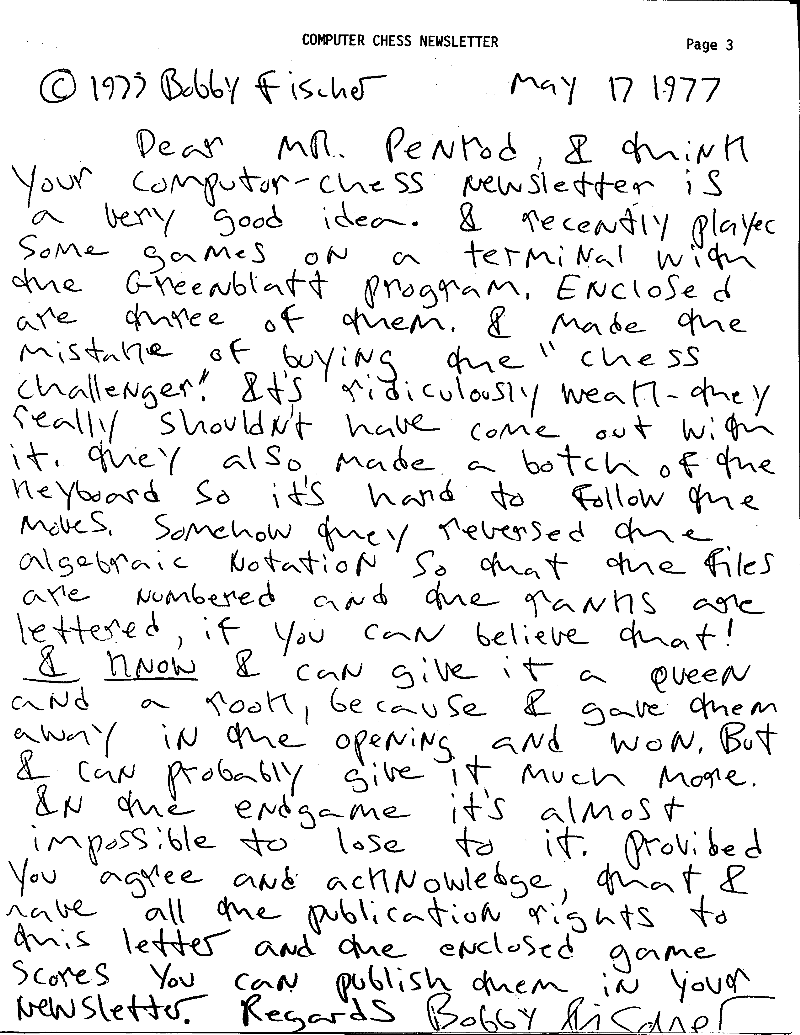 There was only one problem. Bobby Fischer had gone into hiding
after winning in 1972 and declining to compete against Anatoly
Karpov in 1975. Nobody knew where he was or how to reach him.
There was only one problem. Bobby Fischer had gone into hiding
after winning in 1972 and declining to compete against Anatoly
Karpov in 1975. Nobody knew where he was or how to reach him.
We did know that he was interested in chess playing computers. On May 17, 1977, he wrote a letter to Doug Penrod, editor of the Computer Chess Newsletter Issue 1, Issue 2.
The only game Bobby Fischer played in public between 1972 and 1992 was in 1977 when he played three games against the Greenblatt chess program at MIT, which he refers to in this letter.
Doug Penrod, in addition to publishing the Computer Chess Newsletter, was the organizer of the microcomputer chess tournament in 1978. He was passionate about promoting computer chess. At the time he was suffering from terminal cancer and could only work on good days. One of the effects of the radiation treatment he received was that his saliva glands had been destroyed. He always carried with him a huge bottle of water that he had to drink from every few minutes. We were standing outside the hotel in March 1978 when a local cop noticed Doug taking swigs from his bottle. Apparently he thought there was alcohol in the bottle and approached us, demanding to know what Doug was drinking. He had to actually smell the bottle himself before he was convinced it was water. Doug died in November, 1978. The Penrod Memorial Microchess Tournament was held in 1979.
CHESSmate
I was actually soaking in the bathtub one evening, daydreaming and wondering about a name for the product when CHESSmate popped into my head. Eureka! It immediately seemed like a perfect name. I recalled playing with Eastern European immigrants at a local club and hearing them say chess and chessmate instead of check and checkmate. As a companion to play chess with, it was obvious. I did not rise from the tub and run naked down the street, but I did call Chuck Peddle as soon as possible to let him hear my suggestion. CHESSmate became the working name, pending the possibility of finding Bobby Fischer.
Bobby Fischer vs Microchess
On a cold winter afternoon in February, I was sitting at my desk in Toronto when the phone rang. I picked it up and a voice stated bluntly, "This is Bobby Fischer". After I picked myself off the floor, we had a conversation. He was calling because he wanted to play a game against the latest Microchess, which had been mentioned in the Computer Chess Newsletter. I explained that it would require setting up the computer so it would not be possible at that moment, but if he called back tomorrow at the same time, I would be ready to convey his moves and relay the responses.
The next day, he called at precisely the appointed time. To be honest, I was a bit surprised. The computer was ready and we immediately began play. He only played one game. I don't know why I didn't record it. During the time the computer was thinking, I had the chance to discuss the Commodore dedicated chess computer and the idea of his endorsing it by allowing us to call it Bobby in exchange for royalties on sales. Surprisingly, he was open to the idea but would need to play more games against the program before he decided. I asked if we could meet in person and he said he would let me know.
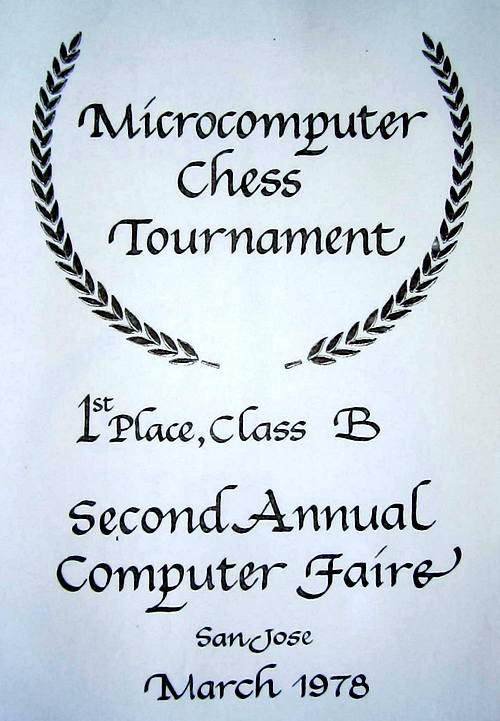 Some time later, I received a phone call from a woman named
Claudia. She was speaking on behalf of Bobby Fischer
and wished to arrange a meeting if we could meet in California.
We scheduled the meeting to be a few days after the Second Annual
West Coast Computer Faire in San Jose, where the program would be playing in
the Microcomputer Chess Tournament. The prototype CHESSmate won the
Class B (<8K) category against
Boris,
CompuChess,
Fidelity Chess Challenger,
Processor Tech 8080 Chess,
Sargon, and
Steve Stuart Chess.
Some time later, I received a phone call from a woman named
Claudia. She was speaking on behalf of Bobby Fischer
and wished to arrange a meeting if we could meet in California.
We scheduled the meeting to be a few days after the Second Annual
West Coast Computer Faire in San Jose, where the program would be playing in
the Microcomputer Chess Tournament. The prototype CHESSmate won the
Class B (<8K) category against
Boris,
CompuChess,
Fidelity Chess Challenger,
Processor Tech 8080 Chess,
Sargon, and
Steve Stuart Chess.
I flew to LA on March 8, drove to Pasadena, and checked in to the Huntington-Sheraton Hotel. I had with me the Ray Holt designed prototype. Claudia called and told me that she would bring Bobby to the hotel the next day.
I almost didn't hear the gentle knock on the door. When I opened the door, Bobby Fischer charged into the room as if he were being pursued by someone in the hallway. As I closed the door, he locked it with the chain, which he did every time we entered.
My instant impression was that he was much taller than I had expected, over six feet. He moved with the gangling awkward motion of a 12 year old who had suddenly grown to be six feet tall. He was wearing a jacket that was too small for his lanky frame. Grubby frayed shirt cuffs protruded over his bony hands. I couldn't decide if his beard was just the result of not shaving for a week, or intentionally short. The waft of BO suggested the former. He wore a leather eyeshade that I never saw him take off. Under his left arm, he was carrying the Boris chess computer. A military style transistor radio dangled by a strap from his right hand.
He was remarkably self-conscious, even shy. There was no conversation. He sat down at the chessboard, turned on his radio full blast, and just began to play. I entered his moves into the computer. It was only after a few minutes of playing chess that he seemed to relax and conversation became possible. He made no comments about the first game.
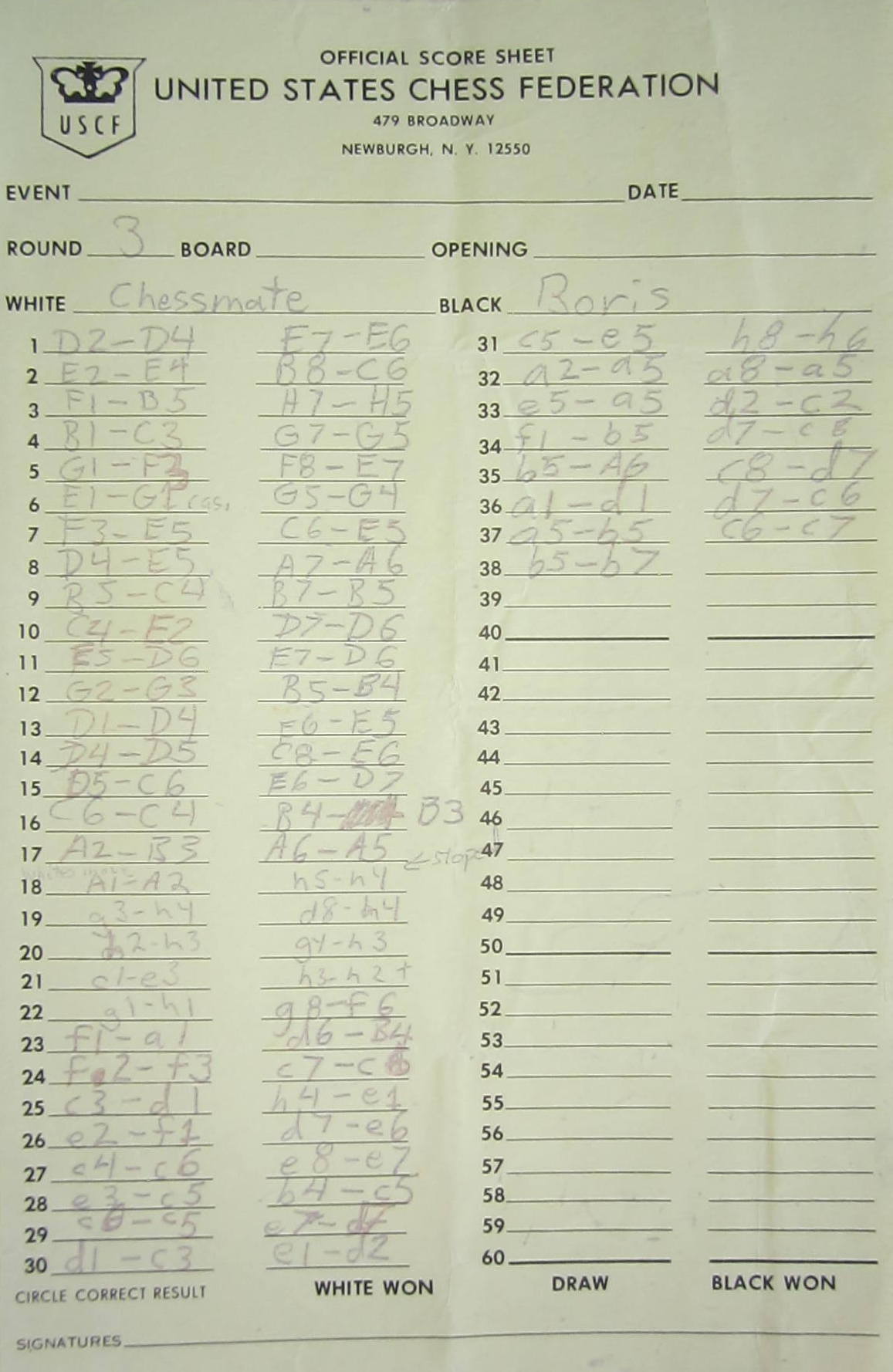 After the first game, he wanted to see CHESSmate play against
the Boris chess computer he had brought. As the games proceeded
he made comments about the moves, pointing out blunders made
by both programs. In the end, he decided that he liked the
style of play of the CHESSmate better, but Boris played better tactically.
This probably reflects the different styles of programming.
Microchess and CHESSmate were built on algorithms borrowed from
Nimzovich's book, My System
and the depth of search was limited by the 256 byte stack page.
Boris was programmed to calculate
a broader and deeper search looking for tactical advantages.
The games often ended in a draw with neither machine showing
superiority. In head-to-head play, CHESSmate had mated Boris in 38 moves at the tournament the week before.
After the first game, he wanted to see CHESSmate play against
the Boris chess computer he had brought. As the games proceeded
he made comments about the moves, pointing out blunders made
by both programs. In the end, he decided that he liked the
style of play of the CHESSmate better, but Boris played better tactically.
This probably reflects the different styles of programming.
Microchess and CHESSmate were built on algorithms borrowed from
Nimzovich's book, My System
and the depth of search was limited by the 256 byte stack page.
Boris was programmed to calculate
a broader and deeper search looking for tactical advantages.
The games often ended in a draw with neither machine showing
superiority. In head-to-head play, CHESSmate had mated Boris in 38 moves at the tournament the week before.
I was astonished that he would often be surprised by a move made by the machine that seemed to me to be an obvious continuation, as if he just didn't see the obvious moves on the board at all. Sometimes his comments were superficial. At other times he would look at a position and immediately recognize it as being similar to important tournament games from the past that he knew intimately. He named the players and the tournament.
After a long afternoon of playing many games, or mostly part games that we reset when the outcome was obvious, I asked him if he would like to join me for dinner. I was actually surprised that he agreed, as I had been warned that he does not like to be seen in public, and to call Claudia to come and pick him up when he was ready to leave.
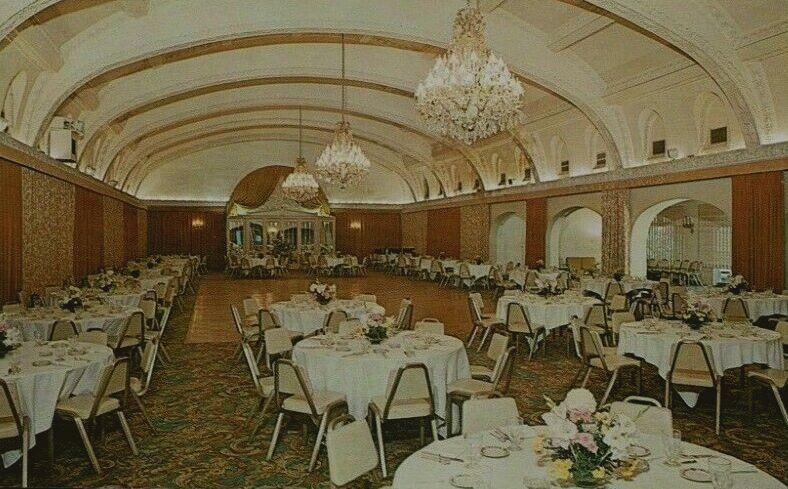 When we went down to dinner in the elegant Ship Room, I was surprised
that he picked up his Boris and transistor radio to take with us.
I was unable to assure him that they would be safe in the room. I
was leaving my computer and everything else, after all.
Walking into the dining room with his paraphernalia tucked
under his arms, unkempt, dressed (and smelling) somewhat like a street person,
complete with the dirty leather eyeshade, he was not avoiding being noticed.
When we went down to dinner in the elegant Ship Room, I was surprised
that he picked up his Boris and transistor radio to take with us.
I was unable to assure him that they would be safe in the room. I
was leaving my computer and everything else, after all.
Walking into the dining room with his paraphernalia tucked
under his arms, unkempt, dressed (and smelling) somewhat like a street person,
complete with the dirty leather eyeshade, he was not avoiding being noticed.
From his almost emaciated appearance, I was not expecting him to eat a lot, but he surprised me with his voracious appetite. He ordered an entree dish as an appetizer and a large stuffed trout for his meal and polished them off with great expedience. I don't know why I expected him not to drink, but he had a couple of whiskey sours with his dinner.
Without the chess board, we attempted conversation. For a while it was as if he had memorized a rote script for antisocial people to make small talk. Sometimes, he seemed to disappear into self absorption. But then he became animated and told me all about the Zionist Illuminati, the Conspiracy of the Money Lenders, and the Protocols of the Elders of Zion. He was passionately paranoid about these people. He believed that they are after him because he is a free thinker and cannot be controlled. Not wishing to antagonize him, I merely nodded and kept quiet. At least he did not raise his voice and speak of kikes and Jew bastards as his friend Ron Gross has reported with embarrassment.
I realize now, but was unaware at the time, that it was his 35th birthday. He had made no mention of it. Claudia had not mentioned it. I wonder if he was even aware of it himself. It is strange that I spent the entire day with him without it being mentioned.
I called Claudia to pick him up after dinner. He does not have a licence to drive. She was astounded that he had come to dinner with me. It was not normally something he would do.
The next day he arrived early and we spent many hours playing the computer. He lay on the bed, listening to his radio tuned to Herbert Armstrong's Worldwide Church of God (chanting Amen at appropriate times), and told me the moves. Occasionally, he drifted off to sleep. Despite the distractions and not actually looking at the board he spotted a mate in four during one of the games that the computer missed.
After lunch he announced that he wanted to show me something. We drove (Claudia later told me that he NEVER rides in a car with anyone but her) to the Huntington Botanical Gardens where he led me through the desert plant section. Apparently he spends quite a lot of time there. He pointed out the plants that interested him, but his child-like attention span lasted only a few seconds before he was on to the next plant or another topic. Again, I felt that I was with a hyperactive 12 year old trapped in a 35 year old body. It was difficult to reconcile this hyperactivity with the hyperprosexia required to play chess at the Grandmaster level.
Another sign of his paranoia was that every time we parked the car he would walk around it and check all four doors. Even though we were leaving nothing of value in it. He seemed always to be afraid. Riding in the elevator was petrifying. Riding in my car had him on edge.
He then asked me if I would drive him to his favourite bookstore and I agreed. The shop contained nothing but antisemitic hate and conspiracy theory books of all kinds. I had never been in such a place. It was an eye opener for me.
He had brought a few books with him for me to read, which he left with me overnight. These included The Conspiracy and Red Cloud over America, and other similar serious books about Zionists and other conspiracies we should beware of. I wrote down the titles at the time, but I can't find any of them on Amazon today.
There was a computer store nearby and he wondered if the new CompuChess game had arrived. He was aware that it was due any day. Before entering the store he gave me some rules because he was so afraid of being recognized. I was not to call him by name. I was not allowed to speak of chess. And, although that was the reason we were going into the store, I should ignore the CompuChess machine myself.
We entered the store and immediately saw a huddle of 10 or more guys around a table. The CompuChess game had arrived and someone was playing a game against it. We joined the group to watch. At one point, someone blurted out, "I wonder what Bobby Fischer would think about this?". I wondered what that person would think if he had known Bobby Fischer was standing right behind him. Immediately, Bobby motioned for us to go and we left the store.
 That night, at dinner, he ordered a Black Russian because that was what I
had had the night before and he wanted to try one.
I joked that if he had 5 of them, I would probably be able
to beat him in a game. He doubted it. He was probably right.
That night, at dinner, he ordered a Black Russian because that was what I
had had the night before and he wanted to try one.
I joked that if he had 5 of them, I would probably be able
to beat him in a game. He doubted it. He was probably right.
I asked him how he spends his time. He replied that he spent most of his time reading about the conspiracy. He told me how homosexuality is one of many forms of moral degradation that is part of the conspiracy.
He never watches television because he is afraid of the radiation from the tube. For that reason he would never use a computer with a CRT monitor.
He told me that he plays against his Boris computer a lot, but he spots it a queen and a rook to make the play interesting. Sometimes he only plays with a king and pawns.
He also told me about his ideas for random chess, where, in the starting position, the pieces are arranged randomly so that there is no advantage to studying the book openings. He wondered what I thought of the idea and encouraged me to write a program to incorporate the game. I pointed out that the CHESSmate has the ability to place the pieces anywhere before starting play so it would be possible to use it that way already.
The next day, we met again in my room. He told me that he wanted to see how I played and challenged me to a game. Afraid of being embarrassed, I hesitated and he offered to spot me a queen to make it more fair. He told me that it would be something I could tell my grandchildren. That I had played against Bobby Fischer, undefeated World Champion.
I did not want to play with a spotted queen so we played a normal game. Only, I had a board and he lay on the bed looking up at the ceiling, telling me what pieces to move for him. The first game lasted about 30 moves and ended in a checkmate. We played two more speed games, just for the fun of it, and he won them both easily, but not in a way that I felt embarrassed by my play.
I pressed him on the idea of naming the Commodore product Bobby, in return for a royalty on sales, perhaps with a signing bonus. It was known that he was not exactly well-off and that his World Championship prize money would not last forever. Unfortunately, he did not feel that our program was good enough yet for his endorsement. I have to wonder, 45 years later, if he had been interested, whether he would have ever signed a contract with Commodore, once he discovered that Jack Tramiel was a Jew and an Auschwitz survivor. I think not.
Sales
The Commodore CHESSmate was officially introduced at the Summer Consumer Electronics Show in Chicago in 1978. Shipments to customers began later that year. The CHESSmate MCU and RRIOT chips were manufactured at MOS Technology in Pennsylvania and hardware was assembled in Hong Kong.
Commodore sold the CHESSmate through all of its distributors, but the product was best received in Germany.
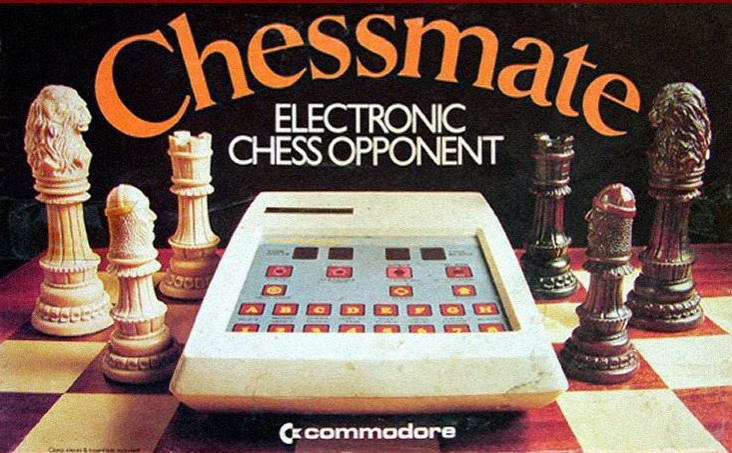 Ad in Personal Computing
Ad in Personal Computing
The contract called for payment of royalties on sales of the CHESSmate or any other product containing the chess playing program code. In 1979, when I moved to California, I called Commodore about the royalty payments that had not been received and reminded them of the interest clause in the contract.
Not long after, I received a small check for sales to date. It did not seem nearly enough, given that the product had been on the market for a year by then. I called Rick Simpson at MOS Technology and asked him if he could find out how many ROMs containing the chess code had been manufactured to date and he called back soon after with a number. It was an order of magnitude more than the reported sales from Commodore's accounting department. So, I called them and we had a little discussion about it. They promised to check into it and call me back.
With a fanfare of apologies, I was told that they had accidentally missed counting the shipments from Hong Kong to Germany. A check would be in the mail for the extra amount plus the penalty interest. Sure enough, I received another, much larger check soon thereafter.
About once a year, I would call Commodore and ask about sales and royalties. They would send me a check with interest shortly afterwards. I do not recall a single instance of receiving a check from them without calling or writing.
I have been told by a former Commodore executive that in general software suppliers were lucky to get 10% of what they were due. "Jack just didn't give a shit about vendors.", he said. Brian Bagnall chronicles the story from inside the company in his excellent book, Commodore - A Company on the Edge. Interviews with Chuck Peddle, John Feagans, Bill Seiler, and other former employees are the source of several chapters.
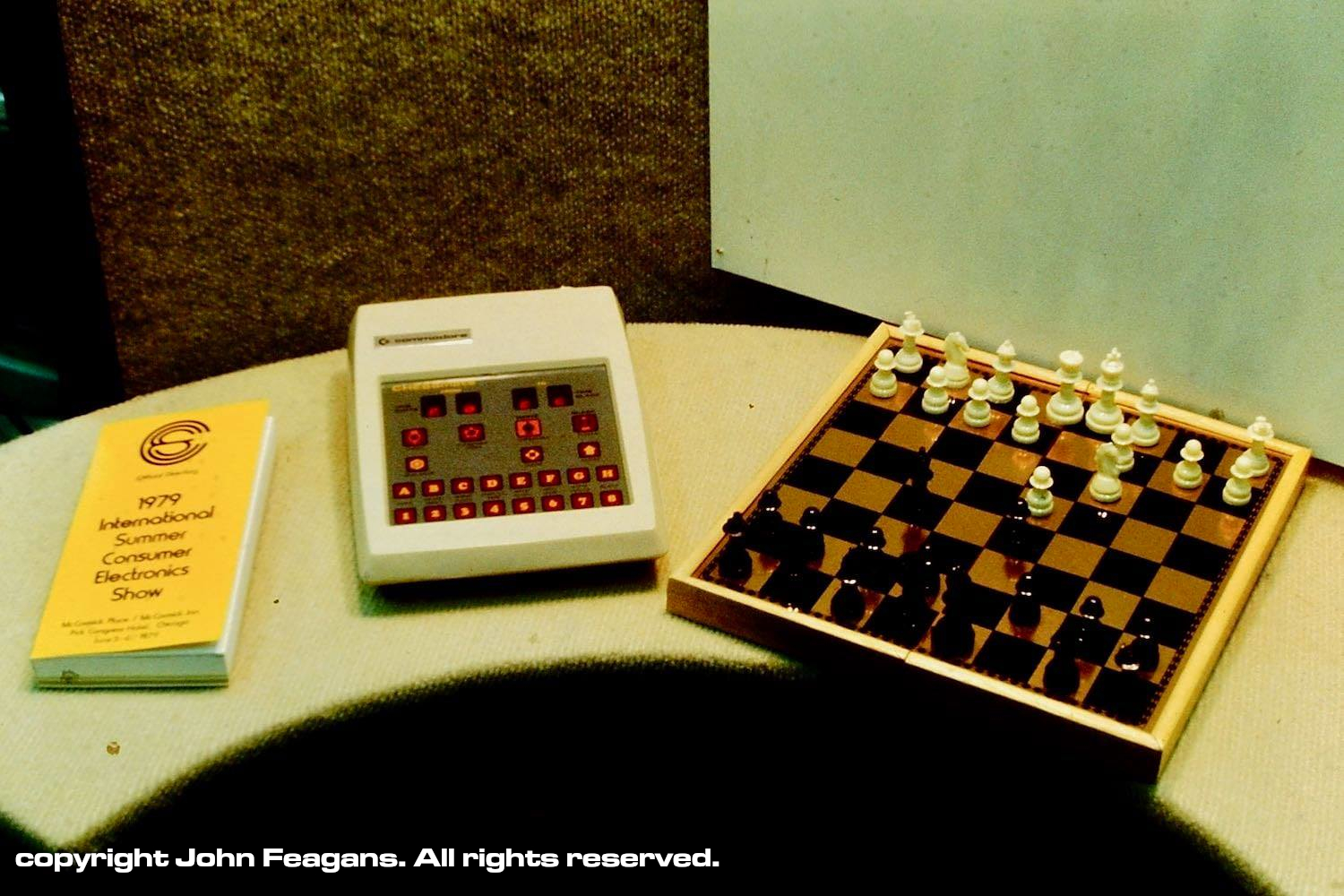
Summer Consumer Electronics Show 1979
Unboxing the Commodore CHESSmate
Novag Chess Champion MK II
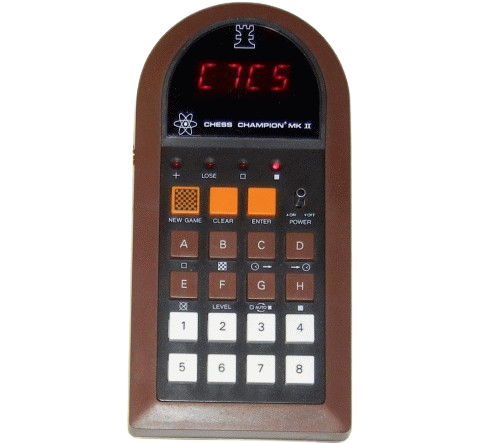 A few years ago, I came across an article that mentioned I had
programmed the Novag Chess Champion MK II computer.
I was about to send a correction to the author, since I was
quite sure that I had not been the programmer.
A few years ago, I came across an article that mentioned I had
programmed the Novag Chess Champion MK II computer.
I was about to send a correction to the author, since I was
quite sure that I had not been the programmer.
But, I did a bit of searching first to see if I could find the source of this fake news. Imagine my surprise when I found a photo of the box, clearly stating that I was the programmer. I also discovered that Novag had been sued by CompuChess for using their code in Novag's first computer, which had sold more than 180,000 units.

Hans Otten's page about CHESSmate with photos of the Novag MKII circuit board clearly shows that the 6530 chips were supplied by MOS Technology. He actually compared the code to verify that it was the same as the CHESSmate. Surprise, surprise! Any bets as to whether Commodore paid royalties on that product?
I hope you have enjoyed reading my recollections of the origins of the CHESSmate. Comments, corrections, and additions are welcome, particularly from Commodore employees involved in the further development of the CHESSmate hardware after my part was completed.
I still hear, from time to time, of collectors acquiring a working CHESSmate and pitting it against other historical chess computers. I have always enjoyed hearing from people whose days have been brightened by encounters with the products I have worked on, and it is particularly rewarding to hear that work I did more than 40 years ago is still bringing joy to someone, somewhere.
2024. Michael Gardi is currently creating a replica CHESSmate. You can follow his progress on Hackaday.
Links
Dave McMurtrie's History of the CHESSmate
Hans Otten: Technical teardown of the CHESSmate.
Hackaday: The Quaint History of the Commodore CHESSmate
Commodore Cave Unboxing Video
Bobby Fischer vs Greenblatt at MIT
Bobby Fischer Biography (ChessManiac)
SI Flashback: Searching for Bobby Fischer
Claudia Mokarov's YouTube Channel
Will Bobby Fischer Rise Again? Chess Voice 1978-79
[PDF]
CHESSmate Simulation video
CHESSmate teardown photos
Commodore - A Company on the Edge. Brian Bagnall. Amazon Books.
CHESSmate simulation for Arduino.
Michael Gardi's CHESSmate Replica project.
Microchess for the KIM-1, by Peter Jennings
VisiCalc, The Early Days by Peter Jennings
CHESSmate on eBay
CHESSmate games show up from time to time on eBay. Search eBay now for CHESSmate
